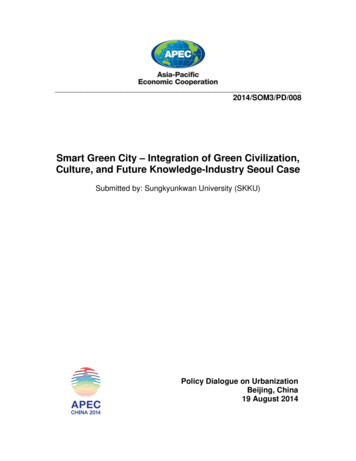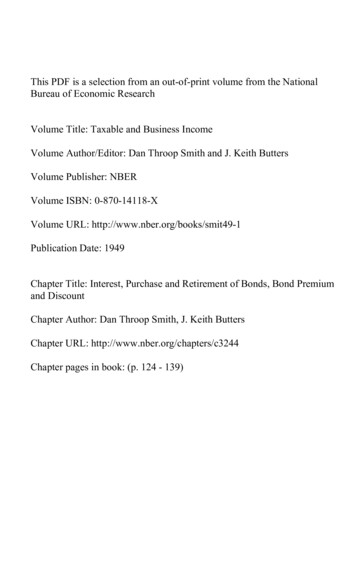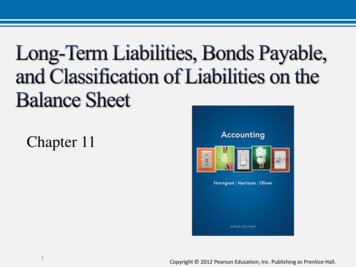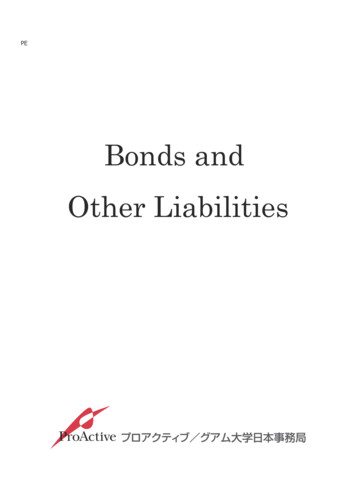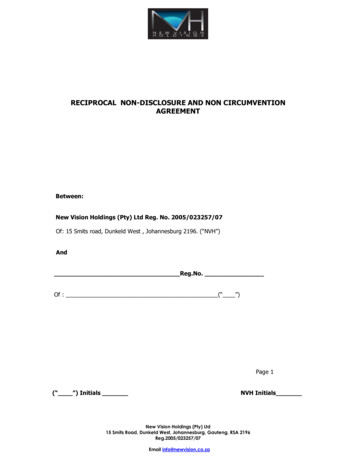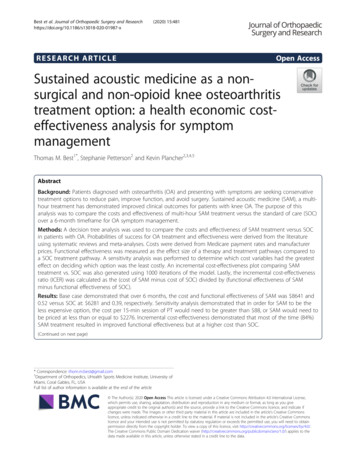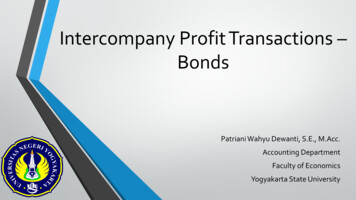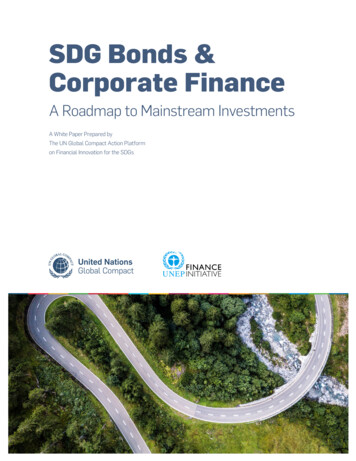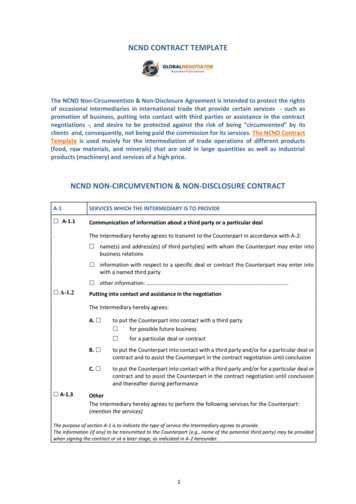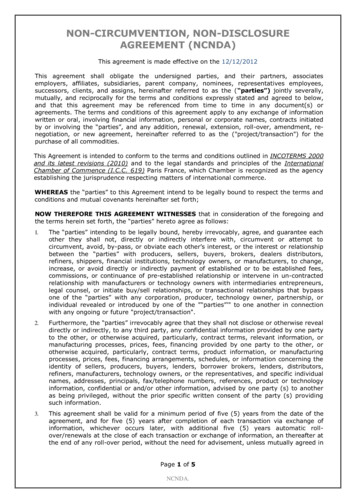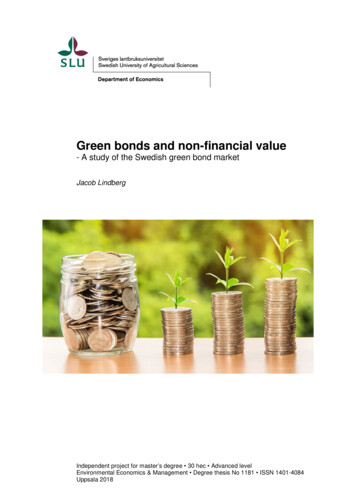
Transcription
Green bonds and non-financial value- A study of the Swedish green bond marketJacob LindbergIndependent project for master’s degree 30 hec Advanced levelEnvironmental Economics & Management Degree thesis No 1181 ISSN 1401-4084Uppsala 2018
Green bonds and non-financial value - a study of the Swedish green bond marketJacob LindbergSupervisor:Carl-Johan Lagerkvist, Swedish University of AgriculturalSciences, Department of EconomicsExaminer:Richard Ferguson, Swedish University of AgriculturalSciences, Department of EconomicsCredits: 30 hecLevel: A2ECourse title: Independent project in business administrationCourse code: EX0807Programme/Education: Environmental Economics & ManagementFaculty: Faculty of Natural Resources and Agricultural SciencesPlace of publication: UppsalaYear of publication: 2018Cover picture: [Rights-free, www.pexels.com]Name of Series: Degree project/SLU, Department of EconomicsNo: 1181ISSN 1401-4084Online publication: http://stud.epsilon.slu.seKey words: Climate change, CSR, CSV, Green bonds, Investors, Portfolio theory,Sustainable FinanceSveriges lantbruksuniversitetSwedish University of Agricultural SciencesFaculty of Natural Resources and Agricultural SciencesDepartment of Economics
AcknowledgementsI would like to convey my sincere gratitude to Tobias Lindbergh, Head of SustainableFinance and the rest of the team at Handelsbanken Debt Capital Markets for making thisstudy possible and educating me in the bond market.I would also like to thank Erika Wranegård at Öhman Fonder AB, Helena Lindahl at SPP,Gunnela Hahn at Svenska kyrkan, Mats Nilsson and Lina Palmborg at Handelsbanken Liv,Alexander Gullnäs at Handelsbanken Fonder and Mikael Andersson at HumlegårdenFastigheter for your contribution that enabled the research.Last but not least, I would like to thank my supervisor Carl-Johan Lagerkvist for all valuableguidance and feedback.iii
AbstractHuman-caused climate change in form of rising temperatures and sea-level rise are alreadybeing seen in many places. To avoid permanent effects on society the goal is to limit globaltemperature rise at two degrees Celsius above pre-industrial levels. In order to stop theincreasing temperature rise, the financial sector has to allocate their funds into investments inrenewable energy and sustainable projects that decrease direct impact on the climate. To solvefor this, new instruments have been developed. One of these is the green bond.This study aims to investigate why investors are interested in green bonds and which greenbonds they prefer. The values that can be obtained from green bonds is also studied, and whatconsequences the green bond investment give in relation to the investor s sustainability strategy/ profile.The empirical information is gathered through interviews with investors that currently holdgreen bonds in their portfolios and a green bond issuer. The empirical data is analyzed togetherwith a theoretical background on CSR, CSV and Portfolio theory.The results of the study show that the main benefits from investing in green bonds are the highlevel of information that increases transparency. The transparency generates a better dialogbetween issuers and investors. Internal dialog regarding sustainability in the investing companyis also increased due to the investment in green bonds. Another benefit is lower long-term riskdue to compliance with possible regulations. The high level of information also let the investorsknow where their money goes and how they contribute to a more sustainable world.The conclusion of this study is that green bonds give equivalent return as conventional bondswhile the information and transparency is higher. The values obtained from green bonds arebetter transparency, increased brand reputation and a higher demand for the investors’ products.Also, being proactive when it comes to possible regulations is a risk-minimizing factor.iv
SammanfattningKlimatförändringar orsakat av människor I form av stigande temperaturer och förhöjdahavsnivåer syns redan på många håll. För att undvika permanenta effekter på samhället är måletatt begränsa den globala temperaturhöjningen till två grader Celsius över den förindustriellanivån. För att stoppa temperaturhöjningen måste den finansiella sektorn allokera medel tillinvesteringar i förnyelsebar energi och hållbara projekt. Detta för att sänka den direkta påverkanpå klimatet. För att lösa detta har nya finansiella instrument utvecklats. Ett av dessa är grönaobligationer.Den här studien syftar till att undersöka varför investerare dras till gröna obligationer och vilkagröna obligationer de föredrar. Även de värden som kan erhållas genom att investera i grönaobligationer undersöks. Vidare undersöks vilka konsekvenser investeringarna i grönaobligationer har i relation till investerarnas hållbarhetsprofil/-strategi.Den empiriska informationen samlas in genom intervjuer med en emittent av gröna obligationersamt investerare som för tillfället har gröna obligationer i deras portföljer. Resultatet frånintervjuerna analyseras tillsammans med den teoretiska bakgrunden över CSR, CSV ochportföljteori.Resultaten visar att de huvudsakliga fördelarna med investeringar i gröna obligationer är en höggrad av information som i sin tur ökar transparensen. Transparensen leder till en bättre dialogemellan investerare och emittent. Den interna dialogen vad gäller hållbarhet i det investerandeföretaget ökar också till följd av investeringarna i gröna obligationer. En annan fördel är lägrerisk på lång sikt till följd av regel-efterlevnad vid potentiella regleringar. Den höga graden avinformation gör också att investeraren vet var deras pengar går och hur de bidrar till en merhållbar värld.Slutsatsen av studien är att gröna obligationer ger likvärdig avkastning som konventionellaobligationer medan informationsflödet och transparensen är högre. De värden som erhållsgenom gröna obligationer är bättre transparens, starkare varumärke och högre efterfrågan avinvesterarens produkter. Och att vara proaktiv när det kommer till eventuella regleringar är enriskminimerande faktor.v
UNPRIUSDVaRAssets under managementBank for International SettlementsCapital Asset Pricing ModelTwenty-first conference of partiesCorporate Sustainable ResponsibilityCreating Shared ValueDebt Capital MarketsEuropean Investment BankEnvironmental Social GovernanceEuropean UnionEuroThe group of 20Green Bond PrinciplesHigh-level Expert Group on Sustainable FinanceInternational Capital Market AssociationMean Variance OptimizationNon-Governmental OrganizationOver The CounterPrice/EarningsReturn on InvestmentStandard & Poor sSustainable Development GoalsSwedish KronaSustainable Responsible InvestmentTask Force on Climate-related Financial DisclosuresUnited NationsUnited Nations Framework Convention on Climate ChangeUnited Nations Principles for Responsible InvestmentUS DollarsValue at Riskvi
Table of Contents1INTRODUCTION . 11.1 Problem background . 11.2 Problem statement . 21.3 Aim and delimitations . 31.3.1 Limitations . 31.4 Structure of the report . 42BACKGROUND. 52.1 Asset Managers and Fiduciary Duty . 52.2 Asset owners . 52.3 Characteristics of Bonds . 52.3.1 Capital markets . 62.3.2 Bond Spreads . 72.3.3 Liquidity . 72.3.4 Maturity . 72.3.5 Coupons . 72.3.6 Credit Rating . 72.3.7 Conventional bonds . 82.4 Green bonds . 82.4.1 Green Bond Principles . 92.4.2 Third-party Review . 92.5 Summary and comparison . 103METHOD. 123.1 Research design . 123.2 Literature Review . 123.3 Qualitative study . 133.3.1 Reliability and Validity . 133.3.2 Quality assurance . 143.4 Case study . 153.4.1 Choice of Case . 153.4.2 Criticism against case studies . 163.4.3 Semi-structured Interviews . 163.5 Collection of Data . 163.6 Data Analysis . 173.7 Ethical considerations . 174LITERATURE REVIEW AND THEORETICAL BACKGROUND . 184.1 Literature review approach. 184.2 Corporate Social Responsibility . 194.2.1 Definition of CSR. 204.2.2 Strategic CSR . 214.2.3 Responsive CSR . 224.3 Creating Shared Value . 224.4 Portfolio Theory . 244.4.1 Value-at-Risk . 254.5 Ethical Investments . 254.6 Summary of theoretical background . 264.6.1 Starting point for this study . 27vii
4.6.2 What values can be obtained from investing in green bonds? . 274.6.3 What consequences does the green bond investment give in relation to theinvestor s sustainability strategy/profile?. 284.6.4 Why are investors interested in green bonds? . 284.6.5 Which green bonds are investors interested in? . 285EMPIRICAL STUDY . 305.1 Interview respondents . 305.1.1 Erika Wranegård, Öhman Fonder . 305.1.2 Helena Lindahl, SPP Fonder . 305.1.3 Mats Nilsson, Handelsbanken Liv . 315.1.4 Gunnela Hahn, Svenska kyrkan . 315.1.5 Mikael Andersson, Humlegården Fastigheter AB . 315.1.6 The issuers perspective on incentives to issue green bonds . 315.1 Green bonds in comparison to conventional bonds . 32Erika Wranegård, Öhman Fonder . 32Helena Lindahl, SPP Fonder . 33Mats Nilsson, Alexander Gullnäs and Lina Palmborg, Handelsbanken Liv . 34Gunnela Hahn, Svenska kyrkan . 355.2 Green bonds from a portfolio optimization perspective. 36Erika Wranegård, Öhman Fonder . 36Helena Lindahl, SPP Fonder . 37Mats Nilsson, Alexander Gullnäs and Lina Palmborg, Handelsbanken Liv . 37Gunnela Hahn, Svenska kyrkan . 375.3 Value added from green bond investments . 38Erika Wranegård, Öhman Fonder . 38Helena Lindahl, SPP Fonder . 39Mats Nilsson, Alexander Gullnäs and Lina Palmborg, Handelsbanken Liv . 40Gunnela Hahn, Svenska kyrkan . 406ANALYSIS AND DISCUSSION . 426.16.26.16.27What values can be obtained from investing in green bonds? . 42Which green bonds are investors interested in and why? . 43General findings . 44Unexpected findings . 45CONCLUSIONS. 467.1Future research . 46REFERENCES . 47APPENDIX 1. INTERVIEW GUIDES . 51viii
List of figuresFigure 2 This diagram shows green bonds issued in Sweden from 2013-2017. Amounts inEUR millions (Climate Bonds Initiative, 2018) (own modification) . 4Figure 3 This figure illustrates the outline of the study (own design) . 4Figure 4 illustration of the Bond Credit Ratings Table (Waring, 2012) . 8Figure 5 “Shades of Green” CICERO, 2018 . 10Figure 6 Illustration of the total outstanding bond market. Total amount 92.2 Trillion in 2016(Bank of International Settlement (BIS), own modification) . 11Figure 7 Illustration of the Green Bond Market in comparison with the Total Bond Market in2016. (Own design) . 11List of TablesTable 1 Illustration of keywords used in the research (Own design) . 18Table 2 Characteristics of CSR and CSV by Moore, 2014 (own modification) . 24Table 3 Summary of Concepts and Theories (own design) . 26Table 4. Cases, types of investor and issuer (own design) . 30ix
1 IntroductionThe first chapter of this study on green bonds and what factors that drives investors to buy themcontains the background of the development of the instrument. More specifically, it discussesthe issues revolving the present research of the subject, this study’s aim and its researchquestions, as well as setting the limitations. Finally, Chapter 1 illustrates the study outline andstructure of the report.1.1 Problem backgroundClimate change is one of the top threats to mankind, with large impacts expected to occur duringthe twenty-first century. The effects of climate change in form of rising temperatures and sealevel rise are already being seen in many places with ecosystems under of stress, affectinghuman well-being (UNEPP, 2018). Human-caused increase in global temperature due togreenhouse (heat-trapping) gas emission will severely affect society and the world as we knowit. To avoid permanent effects on society the UNFCCC (UN Framework Convention on ClimateChange) sets the goal to limit global temperature rise at two degrees Celsius above preindustrial levels (unfccc,int, 2018)The Paris Agreement (COP21) builds upon the UNFCCC and for the first time brings all nationsto take common action to prevent climate change. The Paris Agreement from December 2015aims to increase global response to keep the global warming to well below two degrees C
temperature rise at two degrees Celsius above preindustrial levels. In order to stop the - increasing temperature rise, the financial sector has to allocate their funds into investments in renewable energy and sustainable projects that decrease direct impact on the climate
